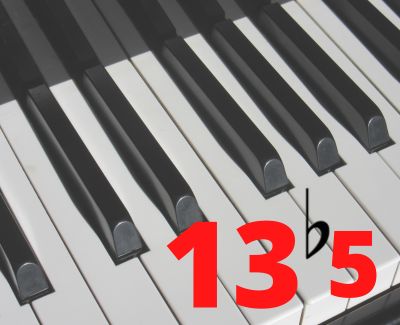If you’re familiar with upper structure chords, you know how easy they are to construct in any key. You play the actual chord in your left hand which is often a shell voicing. These are the bare essentials of a chord that may consist of the root and 7th tones or even the 3rd and 7th tones which have no root at all.

The right hand will often play a simple Major or minor triad which redefines the chord entirely.
 As you can see, putting these two simple chord voicings together creates an extended chord that’s often played in any style of popular music.
As you can see, putting these two simple chord voicings together creates an extended chord that’s often played in any style of popular music.
The great thing about upper structure chords, is that it allows you to create advanced harmony on the keyboard such as altered chords. If you’re not familiar with altered chords, let’s just call them chords that have tones they don’t normally have for now.
In this article, I want to share with you an easy way to play a very professional sounding altered chord. This is the 13 flat 5 chord. A 13 flat 5 chord is an altered chord that contains the root, 3rd, flatted 5th, flatted 7th, and 13th tones. It may or may not contain the 9th tone as it’s to the discretion of the musician. As you can see from the voicing I’ve illustrated above, we have a six note chord. Conventionally, you would need to recall the six different tones to construct this chord.
As you can see from the voicing I’ve illustrated above, we have a six note chord. Conventionally, you would need to recall the six different tones to construct this chord.
But the upper structure concept is a shortcut to simplify this chord voicing and make it much easier for you to construct.
Let’s build the C13 flat 5 chord using the upper structure concept.
First, let's take the root of C and place the flatted 7th above in our left hand.
The next thing we want to do is find the 9th tone in the key of C Major. If you know about extended tones, it’s just as easy as starting on the tonic of C Major and counting up to nine.
Now this is where the upper structure concept comes in. On the 9th tone that you just found, build a simple Major triad upon it with your right hand. In this case, it’s simply a D Major triad. Beyond this D Major triad, add the 2nd tone to it. This would be an E, making it a simple D add2 chord.
Beyond this D Major triad, add the 2nd tone to it. This would be an E, making it a simple D add2 chord.

Putting the chords together in both hands will redefine both chords and render it as the C13 flat 5 chord.
Once you get the concept, you can see it’s simply a Sus2 chord over 7th shell voicing. Knowing keys of music and extended tones gives you the tools to construct this chord in any key.

How can we expand this concept for more options? I’m glad you asked because if you haven't already discovered inversions, you can invert the chord in your right hand for more sound variety.
We know we can play this voicing with the right hand upper structure in root position.

But we can also invert the add2 triad in the right hand.

Since we have four notes in our upper structure chord, we can play it in two more inversions beyond what I’ve already illustrated here.

Where else could we go with our 13 flat 5 chord?
Again, let’s take a look at our C 13 flat 5 upper structure voicing.
 We know we have a sus2 chord in our right hand. This equates to the 9th, 3rd, flat 5 and 13th ones in that order. We can omit the 9th tone if we don't wish to have it in our voicing.
We know we have a sus2 chord in our right hand. This equates to the 9th, 3rd, flat 5 and 13th ones in that order. We can omit the 9th tone if we don't wish to have it in our voicing.
If this is the case, play the add2 chord based on the 9th but leave the root out.
You still have all of the voicing options we’ve looked at previously without the 9th.

There’s also another way to voice this 13 flat 5 chord which gives it a suspended quality. This is even simpler than our original upper structure voicing.
This would be a 13 sus2 flat 5 chord. Instead of playing an add2 chord based on the 9th tone, just play a simple triad based on the 9th tone.
As you can see, there’s no 3rd in the chord. This is what gives the chord its suspended quality because it does contain the 2nd.
Again, you have the option of inverting the upper structure triad in the right hand to expand the chord voicing as a whole.


So how can you use this chord? This type of chord voicing has tension which creates interest. You could use it as a substitution chord for any dominant chord. You could also use it as a passing chord just before a Major or minor chord.
As with any chord that creates interest, experiment and you’ll find ways to breathe new life into your music.
Until next time, Go Play.
Greg Lee
Latest posts by Greg Lee (see all)
- What is a minor/Major 7 Chord? - October 26, 2023
- 7 Chord Substitutions that Professionals Use - October 19, 2023
- 5 Simple Chord Tricks to Sound Amazing - October 5, 2023








